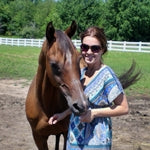See the World Through The Eyes Of A Horse
Andrea Powell
Horses have the largest eyes of any land mammal so this would lead us to believe they have the best vision. Their vision is unique and allows them to spot a predator from a distance.
Horses have monocular (using one eye) and binocular (using two eyes) vision. Monocular vision allows the horse to see almost 360 degrees combined. When a horse is alarmed by something he will switch to binocular vision to get a more detailed look.
How do horses see color, in the dark, motion, and depth? Horses see the world completely different from us, since they are prey animals, and we are predators. Learning how a horse views the world will make you better understand their behavior and thinking.
Can Horses See Color?
Some people think they are colorblind, but they are not. Horses can see color just not as vivid as we see it. It is believed they can see in shades of blue, green, yellow and gray.
To see color the retina of the eye has to have cone cells. These cone cells respond to different wavelengths of light. Humans have three types, while horses and dogs have two types. Hence why dogs and horses are believed to see the same colors.
"Stallions in the wild have often been observed to prefer mares of a particular colour and it's thought this is probably related to their mother's coat colour," reported Horsewyse.
How Do Horses See At Night?
To survive, horses need to be able to gallop off in the middle of the night if a predator approaches. Horses are able to see clearly in the dark and run without stumbling.
Horses are domesticated but their eyes are not built for sudden change in light. In the wild the sun would rise or set and the light would change gradually. Notice how a horse hesitates to enter a dark stall. If you walk into the barn at night and flick on the light your horse will blink multiple times until their eyes adjust to the light.
Just because we cannot see in the dark without a flashlight does not mean horses cannot.
Where Are A Horse's Blind Spots?
Their large eyes mean large retinas, which gives horses great peripheral vision. However, they cannot see directly in front of their nose or behind their tail. Their total vision at one time is 330-350 degrees with only a 10-30 degree of blind spots. Humans can only see 100-130 degrees leaving a large blind spot behind us.
That is why it is important to keep a hand on your horse's hind quarters, and talk to them as you walk behind them in their blind spot. When riding a horse, if you cannot see one of their eyes then you are in their blind spot.
This shows what amazing athletes horses are, since they are jumping and crossing obstacles "blind."
How Does A Horse See Motion?
Have you ever noticed how a horse will turn their head to look at something that scares them? Turning their head eliminates the blind spot and allows the horse to view the scary object in more detail.
They have much better motion detection than we do. Any slight movement is captured to protect against a predator or a plastic bag. A horse's motion detection is very heightened, and you may notice a horse is more reactive when it is windy. There are a lot of things moving and a horse's eye is catching all of them.
Distance
Being a prey animal, they need to be on the watch for predators at all times as they graze. Their eyes are located on the side of their head for a wider view point.
Using the Snellen scale, same one used to measure the distance humans can see, horses have 20/30 vision. Horsewyse states that a dog's vision is 20/50 and cat 20/75.
Depth Perception
You are walking along on the trail and when you reach a puddle in the path your horse freezes, refusing to step in it. This is because a horse's depth perception is not the best because their eyes are located on the side of their head. Their blind spot is directly in front of them. A horse will lower their head and use their binocular vision to improve their depth perception.
Horses are magnificent animals that allow us to experience freedom and a true partner. It is fascinating how they view the world. Hopefully, now you can communicate more efficiently with your horse.
Watch the horse vision simulation below for a look at how a horse views the world.
[media height="315" width="560" provider="facebook" type="iframe" src="https://www.facebook.com/plugins/video.php?href=https%3A%2F%2Fwww.facebook.com%2FHaras.LaCense.Fanpage%2Fvideos%2F1135019499918691%2F&show_text=0&width=560" ad="true"]

Andrea Powell is an animal enthusiast who resides in West Michigan. When not writing, she is exploring the great outdoors with her dogs and horses.






